List of stumbling blocks in Simmelsdorf
The list of stumbling blocks in Simmelsdorf contains the stumbling blocks that were laid by the Cologne artist Gunter Demnig in Simmelsdorf . So far, Stolpersteine have only been laid in the Hüttenbach district . Stumbling blocks remind of the fate of the people who were murdered, deported, expelled or driven to suicide by the National Socialists . As a rule, they are in front of the victim's last self-chosen place of residence.
The first installation took place in 2017.
Jewish life in Hüttenbach
The Middle Franconian village of Hüttenbach was an independent municipality until 1972 and then became part of the municipality of Simmelsdorf . On the occasion of the consolidation of the municipalities, the Hüttenbach municipal archive was lost because it was disposed of as garbage by the Simmelsdorf municipality. The sources are therefore incomplete.
Jews and Christians have settled in Hüttenbach together since the 15th century. At times, the corresponding proportions of the population were balanced. Before 1700, Hüttenbach was the largest Jewish community in the Electorate of Bavaria. Jews lived there as early as 1431, and in 1499 several families who had been expelled from Nuremberg apparently settled in Hüttenbach. A letter of protection for the Jews of Simmelsdorf has been received from 1580. In 1615 there were eight Jewish families in the area, in 1732 there were 42 and in 1769 there were 81. They lived from the cattle and goods trade. Christian August, Duke of Pfalz-Sulzbach, allowed Jewish traders from Schnaittach, Hüttenbach, Ottensoos, Neuhaus and Forth to move their business to the Pfalz-Sulzbach area around 1650. The number of Jewish residents in Hüttenbach fell continuously from the 1830s, from 380 to 134 in 1880 and then further to 60 in 1910, which was only 9.4 percent of the population. There was a synagogue, first mentioned in 1619, and a Jewish school as well as a ritual bath in the basement of the school house. In 1988 an old mikveh was rediscovered in the house at Bürgermeister-Roth-Straße 3. The dead were buried in the Jewish cemetery in Schnaittach. After the dissolution of the rabbinical district Schnaittach, the community belonged to the rabbinical district Schwabach, from July 1932 to the rabbinical district of Ansbach.
Until the beginning of the Nazi era, the Jews of Hüttenbach were fully integrated in the general life of the place, including in the club life. For example, the community member Eduard Isner was a member of the Hüttenbach community council for 25 years, until 1933. Even before 1933 there was anti-Jewish agitation on the part of the National Socialist Mayor Franz Rost, which was initially ignored by the population. In 1935, people of Jewish faith began to be excluded from the village community, but this was mainly due to intimidation by SA members from outside who stood in front of Jewish shops with anti-Semitic slogans and hung banners at the entrance to the village: “Jews and dogs are prohibited”. During the Reichspogromnacht , SA men broke into the synagogue and set fire to Torah scrolls and ritual objects thrown in a pile, the fire brigade tried to extinguish them, but were prevented from doing so. A week later the houses of the people of Jewish faith were confiscated and they left Hüttenbach. On November 28, 1938, the last Jew left the place, on November 29, Hüttenbach was celebrated as "Jew-free". The school became a residential building. In 1948 17 men who took an active part in the pogroms were charged, and some were sentenced to short prison terms.
List of stumbling blocks
| Stumbling block | inscription | Location | Name, life |
|---|---|---|---|

|
HERE LIVED
HELENE HOLY BRUNN JG. DEPORTED 1893 1942 IZBICA MURDERED |
Haunachstrasse 50 |
Helene Heiligenbrunn , called Lene, was born on June 13, 1893 in Hüttenbach. She last lived in Nuremberg. On March 24, 1942, she was deported from there to the Izbica ghetto . She was murdered by the Nazi regime. |

|
HERE LIVED
JULIUS HOLY BRUNN JG. 1911 ASSIGNED 1940 ANSTALT D. DIAKONIE NEUENDETTELSAU POLSINGEN 'RELOCATED' 20.9.1940 HARTHEIM MURDERED 20.9.1940 ACTION T4 |
Mayor-Roth-Strasse 5 |
Julius Heiligenbrunn was born on July 12, 1911 in Hüttenbach. In 1940 he was admitted to the Neuendettelsau Diakonie Institution. On September 13, 1940, he was transferred from Polsingen to Eglfing-Haar near Munich, where he was housed in a so-called "sanatorium and nursing home". One week later he was transferred to the Hartheim killing center , where he was murdered on the same day. Julius Heiligenbrunn was a victim of the T4 campaign . |

|
CLARA
HIRSCHMANN VERH LIVED HERE. NEW JG. DEPORTED 1874 1942 THERESIENSTADT MURDERED April 24, 1943 |
Fichtenbergstrasse 4 |
Clara Hirschmann , married Neu, also Klara, was born on September 7, 1879 in Hüttenbach. She married the cattle dealer Leopold Neu (born 1876 in Wilhermsdorf ) and had a daughter with him, Betty (born 1904). The daughter married Fritz Sämann (born 1899 in Sugenheim ) and had a son with him, David Werner (born 1928). The married couple Clara and Leopold Neu first lived in Wilhermsdorf and then moved to Fürth . Clara Neu was deported from Nuremberg to the Theresienstadt concentration camp on September 10, 1942 with Transport II / 25, Train Da 512 . Her number on the transport was 619. Clara Neu was murdered by the Nazi regime on April 24, 1943 in Theresienstadt.
Her husband had not been deported with her; he committed suicide in Fürth in March 1943. Her daughter Betty was deported to the Izbica Ghetto with her husband and their son in March 1942 ; all three were murdered there. |

|
MATHILDE
HIRSCHMANN VERH LIVED HERE. WOLLENREICH JG. DEPORTED 1874 1942 THERESIENSTADT MURDERED 21.8.1943 |
Fichtenbergstrasse 4 |
Mathilde Hirschmann , married Wollenreich, was born on October 31, 1874 in Hüttenbach. She also lived in Bad Windsheim for a while . Most recently she lived in Nuremberg. She was deported from Nuremberg to the Theresienstadt concentration camp on September 10, 1942. Mathilde Hirschmann was murdered there on August 21, 1943 by the Nazi regime. |

|
BENNO ISNER JG LIVED HERE . 1869 DEPORTED 1942 THERESIENSTADT MURDERED 7.2.1943 |
Haunachstrasse 49 |
Benedikt Isner , called Benno, was born on May 17, 1869 in Hüttenbach. His parents were Joseph Isner (1823–1875) and Emma, née Aischberg (1833–1885). He had seven siblings: Eduard (1860–1942), Klara, later married Selig (1861–1942), Clothilde (1864–?), Sali Bella (1867–1902), Julius (1871–1926), Ludwig (1873–1920) ), Louise (1875-1944). In 1896 he married Salli Estireicher (1874-1953), who came from New York . The couple had one son, Joseph (born July 11, 1897 in Amberg ), who married Irma, nee Merkbucher, on June 17, 1926. There are two daughters from this marriage: Helga (born 1928) and Eleanor (born 1930) in Nuremberg. The family first lived in Amberg and later in Regensburg . Benedikt Isner was deported from Nuremberg to the Theresienstadt concentration camp on September 24, 1942 with Transport II / 26 . His transport number was 618. He was murdered by the Nazi regime on February 7, 1943 in Theresienstadt.
Klara Selig, his sister, was also murdered in Theresienstadt. His heaviest Louise emigrated to Israel and died there in 1944. His wife and son also survived; in 1938 they went to New York. Salli Isner died there on February 7, 1953, Joseph Isner in July 1976 in Cali , Colombia. |

|
JUSTIN ISNER JG LIVED HERE . 1889 ESCAPE FRANCE INTERNED DRANCY DEPORTED 1942 MURDERED IN AUSCHWITZ |
Haunachstrasse 49 |
Justin Isner was born on November 2, 1889 in Hüttenbach. His parents were Eduard Isner (1860-1942) and Bella, née Rosenfelder (1864-1924). He had six siblings: Joseph Isner (1888-1949), Eugen (1891-1965), Emma (1893-1987), Julius (1895-1978), Clotilda (1897-1973) and Siegfried (later Shlomo, 1899-1995) . Benno Isner was his uncle. He moved to Nuremberg. In 1926 he married Babette Friederike Lutz in Nuremberg, born on November 5, 1895 in Nuremberg. The couple had two daughters: Bella (born April 30, 1928) and Ruth Erika (born October 26, 1929). Justin Isner could not imagine that the country he had fought for in World War I would one day expropriate him. When he was suddenly arrested in May 1939, he found that the Nazi threats would probably also be carried out. On the day of his release, he went to a shipping agency and bought four tickets to Havana , Cuba. Two weeks later, on May 13, 1939, with only two suitcases, the family embarked in Hamburg on the St. Louis , which reached its destination but was not allowed to dock. The St. Louis had to return to Europe and docked in Antwerp on June 17, 1939. The Isners spent the next few years in constant fear and poverty in France. After the German troops marched in, they were no longer able to leave the part of France occupied by the Nazi regime. Eventually the family was arrested and interned in the Drancy assembly camp near Paris. On November 6, 1942, Justin Isner was deported from Drancy to the Auschwitz concentration camp and murdered.
- Bella Isner
In 1947 Justin Isner's wife and daughters emigrated to the United States. His wife died early on August 11, 1949 in Manhattan. His daughter Bella married twice, first in 1950 to Ludwig David Schwab (1929-1972), who came from the district of Würzburg, and in 1977 to Erich Uhlfeder (1920-2004), who came from Heidingsfeld in the south of Würzburg. She died childless on August 29, 2012 in Stamford , Fairfield, Connecticut. His daughter Ruth married Erich Gustav Kissinger (born 1930 in Ingolstadt ). The couple had two children, Jacqueline and Ronald Jay. Justin Isner's siblings also survived the Shoah , the youngest in Jerusalem, all others in the United States. |
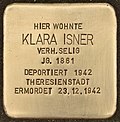
|
KLARA
ISNER VERH LIVED HERE. SELIG JG. DEPORTED 1861 1942 THERESIENSTADT MURDERED December 23, 1942 |
Haunachstrasse 49 |
Klara Isner , married Selig, was born on December 10, 1861 in Hüttenbach. Her parents were Joseph Isner (1823-1875) and Emma, née Aischberg (1833-1885). She had seven siblings: Eduard (1860-1942), Clothilde (1864-?), Sali Bella (1867-1902), Benedikt (1869-1943), Julius (1871-1926), Ludwig (1873-1920), Louise ( 1875-1944). On June 19, 1883, she married the hop trader Hermann Selig in Nuremberg. The couple had five children, all born in Gochsheim near Schweinfurt: Joseph (1884-1928), Justus (1885-1916), Emma (1888), who died as a toddler, Amalie (1889) and Clothilde (1892). Her husband, winner of the Bavarian Military Merit Cross, died on March 13, 1894 when the children were two to ten years old. Then she had to get through the children on her own. In 1908 she sold the house at Sennfelder Strasse 1 in Gochsheim for 10,000 gold marks to Josef Ehrlitzer, but was able to stay upstairs with the children. She ran a grocery store with her daughter Clothilde. Josef Ehrlitzer, the son of the new house owners, looked after them like a mother. He later joined the Jungvolk and the Hitler Youth. Only the eldest son, Joseph Selig, now a lawyer, married. He and his wife Babette had two daughters: Lieselotte (later married Helft-Brummer) and Ilse Emma (later married Kramer). Klara Selig's son Justus served in World War I and fell in France in 1916. The daughters worked in the hospital. Klara and Clothide Selig were known for their generosity and helpfulness, they helped many poor. In 1929 Amalia moved to Regensburg, where she found work as a cashier and later as a director in a department store. From 1939 she lived on the first floor of the house at Heiliggeistgasse 10. In Gochsheim, Klara Selig and her daughter Clothilde have a very difficult time keeping the customers and averting the decline of the business. In 1933 an SA man had opened a rival company, followed by reprisals against the two Jewish women, isolation and abuse. They decided to give up the shop, to leave Simmelsdorf and to live with their daughter Amalie in Regensburg, where they were registered from October 6, 1937. During his vacations from the front, the three women were regularly visited by Josef Ehrlicher, but this was only possible under special security precautions for his protection and protection. Amalie lost her job and Klara Selig's two daughters had to work in a rag recycling company. They belong to the first group of 106 Jews who were deported from Regensburg to Piaski on April 2, 1942. They were allegedly murdered on April 23, 1942 in the Sobibor extermination camp . Klara Selig, now 81 years old, was also forced to leave the apartment and move to the Jewish old people's home at Weissenburgstrasse 31. In early autumn she wrote to daughter-in-law and her second husband:
- Klara Blessed
Klara Selig belonged to the second group of Jews deported from Regensburg. She was deported to the Theresienstadt concentration camp on September 23, 1942 . Klara Selig was murdered there on December 23, 1942, exactly three months after her arrival. Pneumonia was given as the official cause of death. Before 1937 the daughter-in-law, her second husband and the two daughters from their first marriage managed to emigrate to South America. They all managed to survive the Shoah . A second stumbling block was laid for Klara Selig in Regensburg, along with two more for her daughters Amalie and Clothilde, who were gassed in Lublin . |
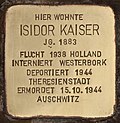
|
ISIDOR KAISER JG LIVED HERE . 1883 ESCAPE 1938 HOLLAND INTERNED WESTERBORK DEPORTED 1944 THERESIENSTADT MURDERED 10/15/1944 AUSCHWITZ |
Mayor-Roth-Strasse 18 |
Isidor Kaiser was born on May 26, 1883 in Hüttenbach. He married Bertha Goldenblum from Weiterstadt (born 1883), the couple had one child. The Kaisers lived in Frankfurt am Main. In 1938 they emigrated to the Netherlands, where they opened a delicatessen shop at Beethovenstraat 8 in Amsterdam . The couple were arrested and interned in Westerbork from May 5, 1944 to September 4, 1944 . On September 4, 1944, Isidor Kaiser and his wife were deported to Theresienstadt on Transport XXIV / 7. His number on the transport was 2019. From there they were deported to the Auschwitz extermination camp on October 12, 1944 with Transport Eq. His number on this transport was 997. Isidor Kaiser and his wife were murdered there on October 15, 1944.
His child survived the Shoah . |
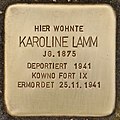
|
KAROLINE LAMM JG LIVED HERE . DEPORTED 1875 1941 KOWNO FORT IX MURDERED 11/25/1941 |
Bürgermeister-Roth-Strasse 3 by the fountain |
Karoline Lamm was born on August 17, 1875 in Hüttenbach. She was deported on November 22, 1941 from Frankfurt am Main to Kaunas in the IX fortas . Karoline Lamm was murdered there on November 25, 1941. |
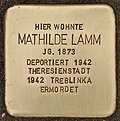
|
MATHILDE LAMM JG LIVED HERE . DEPORTED 1873 1942 THERESIENSTADT MURDERED 1943 TREBLINKA |
Bürgermeister-Roth-Strasse 3 by the fountain |
Mathilde Lamm was born on July 30, 1873 in Hüttenbach. She lived in Laudenbach and most recently in Stuttgart, from where she was deported to Theresienstadt on August 22, 1942 with Transport XIII / 1. Her number on this transport was 573. On September 26, 1942, she was deported to the Treblinka extermination camp on Transport Br . Her number on this transport was 1115. Mathilde Lamm did not survive the Shoah. |

|
HERE LIVED
MORITZ MOSES LAMB JG. DEPORTED 1869 1942 THERESIENSTADT MURDERED 11/26/1943 |
Bürgermeister-Roth-Strasse 3 by the fountain |
Moritz Moses Lamm was born on September 25, 1869 in Hüttenbach. He became a businessman and married Emilie Strauss (born 1880) from Schweinfurt . The couple last lived in Nuremberg at Gostenhofer Hauptstrasse 24. On September 10, 1942, they were deported to Theresienstadt on Transport II / 25, Train Da 512. Moritz Moses Lamm lost his life there on November 26, 1943.
His wife Emilie Lamm lost her life on April 14, 1943, also in Theresienstadt. |
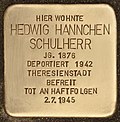
|
HERE LIVED
Hedwig Annette SCHOOL LORD JG. 1876 DEPORTED 1942 THERESIENSTADT RELEASED DEAD OF CONSEQUENCES OF ADJUST July 2nd, 1945 |
Haunachstrasse 48 |
Hedwig Hannchen Schulherr , née Springer, was born on February 28, 1876 in Hüttenbach. She was deported to Theresienstadt on September 10, 1942. They survived and returned to Nuremberg. Hedwig Hannchen Schulherr died there on July 2, 1945 from the consequences of his imprisonment. |

|
BABETTE SUNDHEIMER JG LIVED HERE . DEPORTED 1867 1942 THERESIENSTADT MURDERED December 20, 1942 |
Fichtenbergstrasse 4 |
Babette Sundheimer was born on February 26, 1867 in Hüttenbach. Her mother was Katharina Sundheimer from Munich. She had at least two sisters. In 1890 she moved to Munich and worked there as a saleswoman. Sundheimer did not marry. From 1916 she lived at the inlet 1 / I. In the end she was forced to live in the Milbertshofen Jewish camp . From there she was deported to Theresienstadt on June 24, 1942 with Transport II / 9, her number on the transport was 438. Babette Sundheimer lost her life there on December 20, 1942, the official cause of death was given as the red leg.
Her death certificate lists two sisters who were also in Theresienstadt. These are Jette Hirsch and a married Rosenheim. At least for Jette Hirsch, deported with the same transport with the number 467, completely different parents are given in the memorial book. |
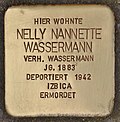
|
HERE LIVED
NELLY Nannette AQUARIUS VERH. AQUARIUS JG. DEPORTED 1883 1942 IZBICA MURDERED |
Mayor-Roth-Strasse 1 |
Nelly Nannette Wassermann , nee Wassermann, was born on September 16, 1883 in Hüttenbach. She was married to the butcher Wilhelm Wassermann (born 1885) from Ermreuth . The couple lived in Nuremberg at Fürther Straße 56. They were deported to Izbica on March 24, 1942. Nelly Nanette Wassermann did not survive the Shoah. Her husband did not survive the Shoah either. |
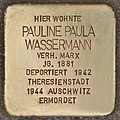
|
HERE LIVED
PAULINE PAULA AQUARIUS BORN MARX JG. DEPORTED IN 1881 1942 THERESIENSTADT MURDERED IN 1944 AUSCHWITZ |
Mayor-Roth-Strasse 1 |
Pauline Paula Wassermann , married Marx, was born on May 14, 1881 in Hüttenbach. She married Eduard Marx (born 1877) from Zeltingen-Rachtig and lived in Zeltingen-Rachtig. Her two daughters were born there: Betty (born 1905) and Irma (born 1906). From November 15, 1938 to November 20, 1938, Paula Marx's husband was interned in the Dachau concentration camp ; a few months later, in 1939, the couple moved to Cologne and finally to Traben-Trarbach . The couple were deported from Cologne to Theresienstadt on July 27, 1942 with Transport III / 2. Paula Marx's number on this transport was 913. On May 15, 1944, she and her husband were deported to the Auschwitz extermination camp on the DZ transport. Her number was 875. Paula Marx did not survive the Shoah.
Eduard Marx did not survive the Shoah either. Her daughter Betty, divorced Tobias, had emigrated to Antwerp and was deported from there to Auschwitz in September 1942. Her daughter Irma, married Höflich, was deported to Riga with her husband in 1941 and finally murdered in the Stutthof concentration camp in 1944 . Stumbling blocks were laid for her and her husband in Nettetal . |
laying
The Stolpersteine in Hüttenbach were laid by the artist Gunter Demnig personally in 2017 and 2019.
Web links
- Chronicle of the laying of the stumbling blocks on the website of Gunter Demnig's project
Individual evidence
- ^ Alemannia Judaica : Hüttenbach | On the history of the Jewish community , accessed on June 21, 2020
- ↑ From the history of the Jewish communities in the German-speaking area: Hüttenbach (Middle Franconia / Bavaria) , accessed on June 21, 2020
- ↑ "Zachor - Remember! ..." , accessed on June 21, 2020
- ↑ Memorial book victims of the persecution of Jews under the National Socialist tyranny in Germany 1933–1945: Heiligenbrunn, Helene , accessed on June 19, 2020
- ↑ a b c d Online project fallen memorials: Hüttenbach (Jews), Simmelsdorf community, Nürnberger Land district, Middle Franconia, Bavaria , accessed on June 19, 2020
- ^ Commemorative book victims of the persecution of Jews under the National Socialist tyranny in Germany 1933–1945: Hirschmann, Klara Clara , accessed on June 19, 2020
- ↑ Chronicle Fürth 1933 - 1945 , accessed on June 19, 2020
- ^ Commemorative book victims of the persecution of Jews under the National Socialist tyranny in Germany 1933–1945: Sämann, Betty Betti , accessed on June 19, 2020
- ^ Commemorative book victims of the persecution of Jews under the National Socialist tyranny in Germany 1933–1945: Sämann, Fritz , accessed on June 19, 2020
- ↑ Commemorative Book Victims of the Persecution of Jews under the National Socialist Tyranny in Germany 1933–1945: Sämann, David Werner , accessed on June 19, 2020
- ^ Jews in Erlangen , accessed on June 19, 2020
- ^ Alemannia Judaica: Bad Windsheim (Neustadt an der Aisch - Bad Windsheim district) Jewish history / synagogue , accessed on June 19, 2020
- ^ Commemorative book victims of the persecution of Jews under the Nazi tyranny in Germany 1933–1945: Wollenreich, Mathilde , accessed on June 19, 2020
- ↑ holocaust.cz: BENNO ISNER , accessed on February 19, 2020
- ↑ a b c Wolfgang Appell: Jews in Erlangen, Volume II (I - L) , Volume II (I - L) Military Service - First World War, List of Jewish soldiers in units of the Royal. Bayer. Army located in Erlangen 1914-1919, last update 2019 (with photos of Justin Isner's parents and home, also a photo of J. Isner with both daughters in the mountains)
- ↑ Stolpersteine Regensburg: Stolpersteine for Klara, Amalia and Clothilde Selig traces of life , accessed on June 20, 2020
- ^ Commemorative book victims of the persecution of Jews under the Nazi tyranny in Germany 1933–1945: Kaiser, Isidor , accessed on June 20, 2020
- ^ Commemorative book victims of the persecution of Jews under the National Socialist tyranny in Germany 1933–1945: Kaiser, Bertha Berta , accessed on June 20, 2020
- ↑ Joodsamsterdam - Joodse sporen in Amsterdam en omgeving , accessed on June 20, 2020
- ↑ The Central Database of Shoah Victims' Names : ISIDOR KAISER , accessed June 20, 2020
- ^ Commemorative book victims of the persecution of Jews under the Nazi tyranny in Germany 1933–1945: Lamm, Karoline Lina , accessed on June 20, 2020
- ↑ Commemorative Book Victims of the Persecution of Jews under the National Socialist Tyranny in Germany 1933–1945: Lamm, Mathilde , accessed on June 20, 2020
- ↑ holocaust.cz: MATHILDE LAMM , accessed on June 20, 2020
- ^ Commemorative book victims of the persecution of Jews under the National Socialist tyranny in Germany 1933–1945: Lamm, Moritz M. , accessed on June 21, 2020
- ↑ Lamm, Emilie b. Strauss , accessed on June 21, 2020
- ↑ Deportation list , accessed on June 21, 2020
- ^ Commemorative book victims of the persecution of Jews under the National Socialist tyranny in Germany 1933–1945: Lamm, Emilie , accessed on June 21, 2020
- ^ Commemorative book victims of the persecution of Jews under the Nazi tyranny in Germany 1933–1945: Schulherr, Hedwig Hannchen , accessed on June 21, 2020
- ^ Commemorative book victims of the persecution of Jews under the Nazi tyranny in Germany 1933–1945: Sundheimer, Babette , accessed on June 21, 2020
- ↑ City Archives Munich Biographical Memorial Book of Munich Jews 1933-1945: Search Sundheimer, Babette , accessed on June 21, 2020
- ↑ Jewishmuseum.cz: Babette Sundheimer's death certificate , accessed on June 21, 2020
- ^ Commemorative book victims of the persecution of Jews under the National Socialist tyranny in Germany 1933–1945: Wassermann, Nelli Nanette Nannette , accessed on June 21, 2020
- ↑ Wolfgang Appell: Jews in Erlangen Volume II (T - Z), Military Service - First World War, p. 16
- ↑ List of Nuremberg's Victims of Shoah , accessed June 21, 2020
- ^ Commemorative book victims of the persecution of Jews under the National Socialist tyranny in Germany 1933–1945: Wassermann, Wilhelm , accessed on June 21, 2020
- ^ NS-Doc: Paula Marx , accessed on June 21, 2020
- ↑ The Central Database of Shoah Victims' Names: PAULA MARX , accessed June 21, 2020
- ^ Commemorative book victims of the persecution of Jews under the National Socialist tyranny in Germany 1933–1945: Tobias, Betty , accessed on June 21, 2020
- ↑ The Central Database of Shoah Victims' Names: BETTY TOBIAS , accessed June 21, 2020
- ^ Commemorative book victims of the persecution of Jews under the Nazi tyranny in Germany 1933–1945: Marx, Eduard , accessed on June 21, 2020
- ^ Commemorative book victims of the persecution of Jews under the Nazi tyranny in Germany 1933–1945: Höflich, Babette Babetta Irma , accessed on June 21, 2020
- ↑ Jews in Traben-Trarbach , accessed on June 21, 2020
- ↑ Belgisch staatsblad, issues 274-334, p. 8396 , accessed on June 21, 2020

